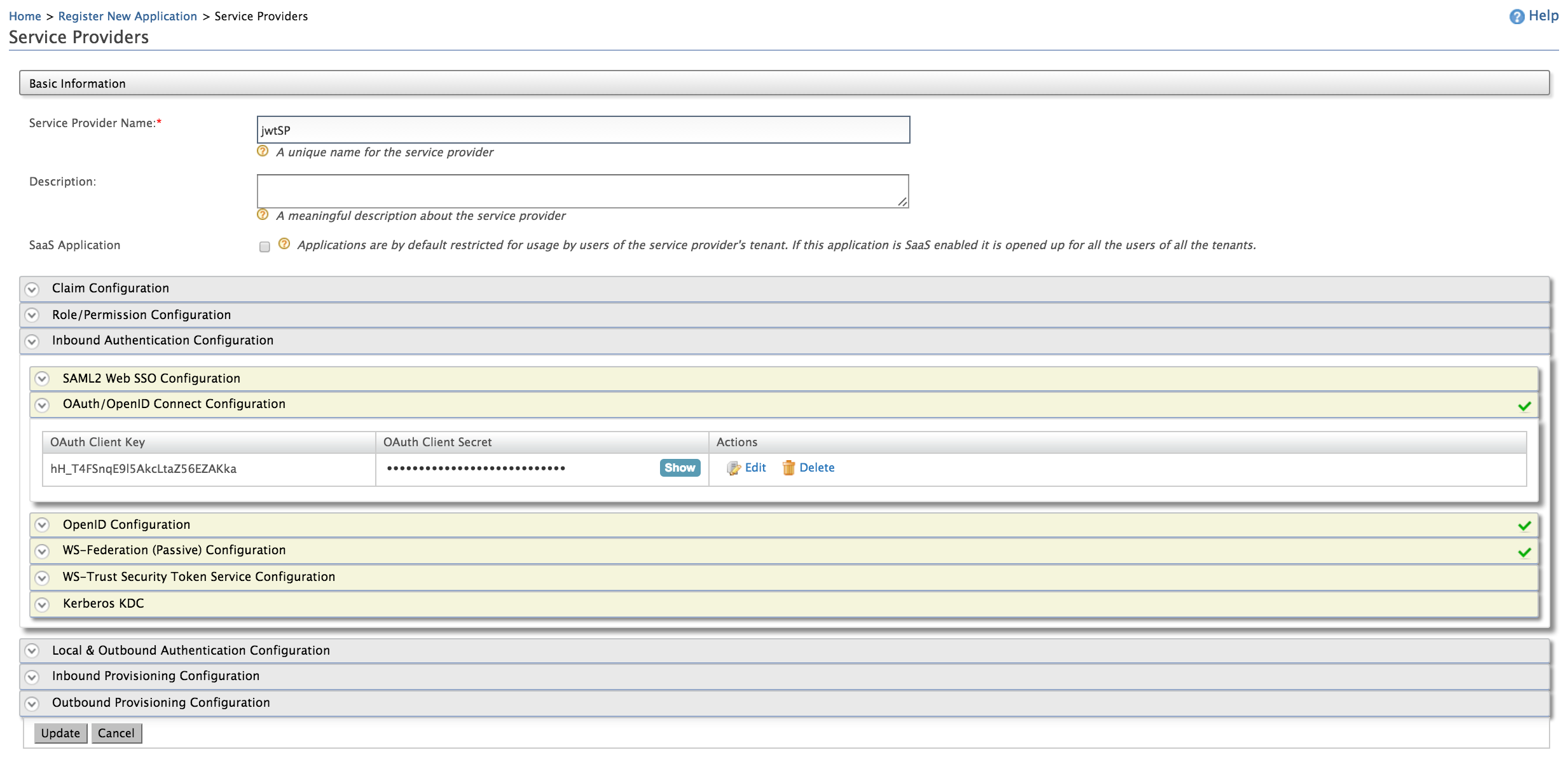JWT Grant¶
The JSON Web Token(JWT) bearer grant is simply a JSON string containing claim values that will be evaluated and validated by the JWT Grant Handlers at the Authorization Server end, before issuing an access token.
WSO2 API Manager, as an OAuth 2.0 Authorization Server with its key manager features, can accept JWT Assertions from OAuth 2.0 clients as means of resource owner authentication and authorization. Additionally, it can exchange the JWT access token with OAuth 2.0 access tokens in order to access protected resources on behalf of the resource owner.
Configuring the JWT grant¶
-
Sign in to the WSO2 API Manager. Enter your username and password to log on to the Management Console ( https://localhost:9443/carbon ).
-
Navigate to the Identity Providers section under the Main tab of the management console and click Add.
-
Provide the following values to configure the IDP:
- Identity Provider Name: Enter an issuer name as the identity provider name. This is used to generate the JWT assertion.
- Identity Provider Public Certificate : The certificate used to sign the JWT assertion.
Info
Identity provider Public Certificate
The Identity Provider Public Certificate is the public certificate belonging to the identity provider. Uploading this is necessary to authenticate the response from the identity provider.
This can be any certificate. If the identity provider is another API Manager or Identity Server, this can be a
wso2.crtfile.To create the identity provider certificate from the
wso2carbon.jks file, follow the steps gievn below.1. Open your command line interface, go to the
<APIM_HOME>/repository/resources/security/directory. Run the following command.
2. Once you run this command, thekeytool -export -alias wso2carbon -file wso2.crt -keystore wso2carbon.jks -storepass wso2carbonwso2.crtfile is generated and can be found in the<APIM_HOME>/repository/resources/security/directory. Click Choose File in Identity Provider section in Management Console and navigate to this location in order to select and upload this file.See Using Asymmetric Encryption in the WSO2 Product Administration Guide for more information on how public keys work and how to sign these keys by a certification authority.
- Alias : Give the name of the alias if the Identity Provider identifies this token endpoint by an alias (e.g.,
https://localhost:9443/oauth2/token). For more information, see Adding a new identity provider.
-
Navigate to the Main menu to access the Identity menu. Click Add under Service Providers.
-
Fill in the Service Provider Name and provide a brief Description of the service provider. See Adding a Service Provider for more information.
-
Expand the OAuth/OpenID Connect Configuration under Inbound Authentication Configuration and click Configure.
-
Enter a Callback URL . For example, use
https://wso2is.local:8080/playground2/oauth2clientand click Add. The OAuth Client Key and OAuth Client Secret will now be visible.
Using the JWT grant¶
The cURL commands below can be used to retrieve the access token and refresh the token using a JWT.
curl -i -X POST -u <clientid>:<clientsecret> -k -d 'grant_type=urn:ietf:params:oauth:grant-type:jwt-bearer&assertion=<JWT>' -H 'Content-Type: application/x-www-form-urlencoded' https://localhost:<HTTPS-port>/tokencurl -i -X POST -u liXJsel4bJ76arbg3DXC3rU4w60a:wQEYq83njU29ZFbpQWdZsUlXcnga -k -d 'grant_type=urn:ietf:params:oauth:grant-type:jwt-bearer&assertion=<JWT>' -H 'Content-Type: application/x-www-form-urlencoded' https://localhost:8243/tokenThe -u flag should specify the “ <Client Id>:<Client Secret> ” value. The assertion parameter value is the signed base64 encoded JWT.
The value of the assertion parameter MUST contain a single JWT. You can refer JWT Bearer Grant for more information about assertion.
Info
If you have configured the service provider and identity provider in a tenant, you have to add the tenant domain as a query parameter to the access token endpoint.
If the tenant domain is wso2.com , the access token endpoint will be as follows.
Access Token Endpoint: https://localhost:8243/token?tenantDomain=wso2.comSample request
curl -i -X POST -H 'Content-Type: application/x-www-form-urlencoded' -u bBhEoE2wIpU1zB8HA3GfvZz8xxAa:RKgXUC3pTRQg9xPpNwyuTPGtnSQa -k -d 'grant_type=urn:ietf:params:oauth:grant-type:jwt-bearer&assertion=eyJhbGciOiJSUzI1NiJ9.eyJleHAiOjE0NTgxNjY5ODUsInN1YiI6ImFkbWluIiwibmJmIjoxNDU4MTA2OTg1LCJhdWQiOlsiaHR0cHM6XC9cL2xvY2FsaG9zdDo5NDQzXC9vYXV0aDJcL3Rva2VuIiwid3NvMi1JUyJdLCJpc3MiOiJqd3RJRFAiLCJqdGkiOiJUb2tlbjU2NzU2IiwiaWF0IjoxNDU4MTA2OTg1fQ.ZcxdoTVEsWoil80ne42QzmsfelMWyjRZJEjUK1c2vMZJjjtrZnsWExyCA5tN6iXYFAXC_7rkFuuNSgOlBi51MNLPZw3WcgGI52j6apGEW92V2tib9zRRWOeLQLAdo8ae8KzLp7kuKZ2XunfQ2WYU9TvvLDm_vp5ruuYz3ZZrJOc' https://localhost:8243/tokenYou would have now received the response from the token endpoint. The response would contain the access token, refresh token, expiry time and token type.
Sample response
{"token_type":"Bearer","expires_in":3600,"refresh_token":"b1b4b78e2b0ef4956acb90f2e38a8833","access_token":"615ebcc943be052cf6dc27c6ec578816"} JWT Bearer Grant¶
JWT contains three parts that are separated by dots ".":
- header
- payload
- signature
The header identifies the algorithm used to generate the signature. For example, see the following code block.
Sample header
{
"alg":"RS256"
}The payload contains the claims mentioned below:
iss (issuer) |
The JWT must contain an iss (issuer) claim that contains a unique identifier that identifies the identity provider that issued the JWT. |
sub (subject) |
The JWT must contain a sub (subject) claim that identifies the entity that the identity provider or the entity that issued the JWT vouches for. |
aud (audience) |
The JWT must contain an aud |
exp (expiration time) |
The JWT must contain an exp |
nbf (not before) |
The JWT may contain a nbf |
iat (issued at) |
The JWT may contain an iat |
jti (json web token ID) |
The JWT may contain jti |
| Other custom claims | JWT may contain claims other than the above mentioned ones. This is the extension point of the JWT specification. |
For example, see the following code block.
Sample payload
{
"sub":"admin",
"aud":[
"https://localhost:9443/oauth2/token"
],
"nbf":1507546100,
"iss":"jwtIDP",
"exp":1507606100,
"iat":1507546100,
"jti":"Token56756"
}The signature is calculated by base64 URL encoding the header and payload and concatenating them with a period as a separator and signing it:
Signature = sign(encodeBase64(header) + '.' + encodeBase64(payload))The signature must then be base64 URL encoded. JWT assertion can be generated by concatenating these three encoded values with a separator dot ".".
assertion = encodeBase64(header) + '.' + encodeBase64(payload) + '.' + encodeBase64(signature)The result is as follows:
Sample assertion
eyJhbGciOiJSUzI1NiJ9.eyJzdWIiOiJhZG1pbiIsImF1ZCI6WyJodHRwczpcL1wvbG9jYWxob3N0Ojk0NDNcL29hdXRoMlwvdG9rZW4iXSwibmJmIjoxNTA3NTQ2MTAwLCJpc3MiOiJqd3RJRFAiLCJleHAiOjE1MDc2MDYxMDAsImlhdCI6MTUwNzU0NjEwMCwianRpIjoiVG9rZW41Njc1NiJ9.iGMhjibB0W2QFQlM27gnHp6z47Eybv8cAHk2o2i-xqo2S4uJ_1VppFI4CCJXTj4qzV9vmkJ5HKNAayiTa6wOMXGL4XnwYwpOAoKXvboznlEDNRpw3htW34nLvyUu6PjHbdvAPVjh8kPRwf7esRr2p-luecGvC21mjWdhyGzM4hETip
If you want to disable the JWT Bearer grant type in the APIM instance, add the following entry to the deployment.toml file in the <APIM_HOME>/repository/conf/ folder.
[oauth.grant_type.jwt_bearer]
enable = false
